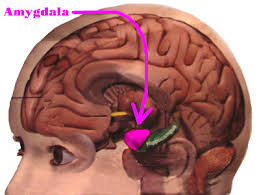Fear and pleasure in the amygdala
Here is a heads up for a recent studydemonstrating – again – that the amygdala is not merely a “fear centre” in the brain. I have previously blogged about the amygdala, first not being a single structure, and that it is not only involved in fear.
In 2007, a team of French researchers demonstrated that direct stimulation of the amygdala did evoke emotional responses, but that there was a difference between which hemisphere was stimulated. Right amygdala stimulations induced aversive responses, in particular fear and sadness. In contrast, left hemisphere stimulation induced either positive (happiness) or negative emotions (fear, anxiety, sadness). As the abstract reads:
“Very few studies in humans have quantified the effect obtained after direct electrical stimulation of the amygdala, in terms of both emotional and physiological responses. We tested patients with drug-resistant partial epilepsies who were explored with intracerebral electrodes in the setting of presurgical evaluation. We assessed the effects of direct electric stimulations in either the right or the left amygdala on verbally self-reported emotions (Izard scale) and on psychophysiological markers of emotions by recording skin conductance responses (SCRs) and by measuring the electromyographic responses of the corrugator supercilii (EMGc). According to responses on Izard scales, electrical stimulations of the right amygdala induced negative emotions, especially fear and sadness. In contrast, stimulations of the left amygdala were able to induce either pleasant (happiness) or unpleasant (fear, anxiety, sadness) emotions. Unpleasant states induced by electrical stimulations were accompanied by an increase in EMGc activity. In addition, when emotional changes were reported after electrical stimulation, SCR amplitude for the positively valenced emotions was larger than for the negative ones. These findings provide direct in vivo evidence that the human amygdala is involved in emotional experiences and strengthen the hypothesis of a functional asymmetry of the amygdala for valence and arousal processing.”
nterestingly, there is more to say about this study. First, it may be that there is a systematic bias introduced by the way the researchers did the study. By using high-frequency (50 Hz) stimulation in 1 second, they might have induced one characteristic response of the amygdala. This structure is often seen as having quick “on-off” responses. Thus, one second pulse trains is actually a long duration for the amygdala. So a pulse of 20 milliseconds could be hypothesised to produce different responses. Also, the researchers found that GSR responses were actually larger for positive emotions, when they were reported. As the amygdala has often been implicated in unconscious emotional responses (mostly aversive responses) one may speculate that the left-hemisphere amygdala involvement in positive emotions may be related to conscious emotions.
As always, new findings leads to numerous novel questions, ideas and hypotheses. Which is why science is so much fun. But it is important to note the change we see today the role of the amygdala in emotional responses. We are moving away from the LeDouxian paradigmatic focus on fear (and some aversion)as the sole emotion of the brain, and more towards a balanced view towards a similar focus on positive emotions and (hopefully) more complex human emotions. Through this development, we can see that novel findings are breaking down the old ideas of neo-phrenology, breaking single structures into smaller parts, and into parts of a larger network of convergence and divergence structures. Keep your eyes open, more is on the way.
-Thomas


